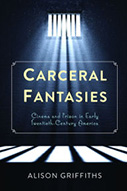Carceral Fantasies: Cinema and Prison in Early Twentieth Century America

Author: Alison Griffiths
Publisher: New York: Columbia University Press, 2016. 472p.
Reviewer: Dawn K. Cecil | May 2017
Prison films are the most commonly examined form of prison imagery. Numerous authors have written about the history of these films, dissected the genre, and attempted to uncover the underlying messages about incarceration in the United States. While some mention silent films, the point of inquiry typically begins with the 1930s, which is known as the golden era of the prison films. Carceral Fantasies: Cinema and Prison in Early Twentieth Century America by Alison Griffiths brings a fresh take to the subject by examining films primarily made before 1915, and shown to prisoners from 1909 until 1922. Even the most well-versed in prison films will find themselves fascinated with the earliest beginnings of this genre and the role movies played in prison life. While much of the previous work considers how the visual imagery impacts those who have never set foot into a prison, through Griffiths’ examination we see what films did for those incarcerated and how it provided a voice for prison reform. Carceral Fantasies introduces readers to “how motion pictures and the penitentiary in the United States came into contact, both figuratively and literally, in the first two decades of the twentieth century” (p. 1). Griffiths uses textual analysis combined with both cultural and penal history to fill “a striking gap in our understanding of cinema’s usefulness in progressive penal reform and illuminates the little-known story of Hollywood’s relationships to prisons, which included studios supplying films free of charge in exchange for location shooting” (p. 5). While there is an abundance of work examining prisons as a theatrical subject, Griffiths explores the prison as cinematic venue. She uncovers the role of movie-going in early 20th century prisons, which contributed to prisoners becoming “among the nation’s most frequent film goers” (p. 145).
The author divides Carceral Fantasies into three sections to examine the carceral imaginary, spectator, and reformer. In “The Carceral Imaginary,” she asks, “why are we fascinated by images of punishment, more extremely, the extinction of life, and how has the popular visual culture throughout the ages catered to this lurid curiosity” (p. 13)? While answering these questions, she takes readers on a journey through people’s fascination with electricity, death, and incarceration. From Houdini owning an electric chair and escaping from it in one of his acts, to everyday people volunteering to pull the lever in real executions, she demonstrates that people were captivated with the power of electricity, especially in the context of life-ending punishment. With this enthrallment came footage of executions, which according to Griffiths, “have contributed to a carceral imagination about what goes on in the darkest recess of the penitentiary” (p. 54). After a detailed examination of these early execution films, Griffiths dissects the visual symbolism contained within art and films. She analyzes the meaning behind typical prison imagery including light shining through bars, prison stripes, and the lockstep. She uncovers how escapes became an integral part of prison films by providing “a perfect handmaiden for the chase, a staple of early narrative cinema” (p. 82). Through this textual analysis of both art and film, Griffiths demonstrates that standard elements of prison films emerged well-before their golden age — for that matter, even before the invention of film.
Perhaps the most interesting aspect of Carceral Fantasies is part two, “The Carceral Spectator.” Griffiths begins by examining how films found their way into America’s penitentiaries. She traces the history of lectures, concerts, sports, and vaudeville in prison, each of which was believed to have reformative powers, especially through their ability to alleviate the perpetual boredom of incarcerated life. These activities made prison life more tolerable, while making prisoners more compliant. The success of these forms of entertainment paved the way for cinema behind the walls. Films gave the incarcerated a glimpse of the outside world. Griffiths observes that for some this was like pouring salt on a wound, for others it was a way to momentarily escape.
While the earliest account of film behind prison walls was in 1907 at Western State Penitentiary in Pittsburgh, Sing Sing Prison in New York was central to the development of prison films. Using this prison as a case study, the author provides an in-depth exploration into the role of cinema behind bars, which offers a perfect demonstration of the symbiotic relationship between some filmmakers and prison administrators. In this part of the book, as well as in the third, Griffiths writes about two of Sing Sing’s most famous wardens—Lawes and Osborne—each of whom crafted a relationship with the movie making industry. For example, books written by Lawes were turned into films, while Osborne was considered a “key figure in [the] enmeshing of motion picture and reform in New York State” (p. 234). Literature on prison films often notes that wardens were used as consultants on these films, but Griffiths shows us that there was a much deeper connection between the penal system and the movie industry.
According to the author, despite the potential dangers of showing films to a large number of prisoners in a dark environment, making inmates carceral spectators served several purposes. Films offered a way to “amuse and control the inmate population” (p. 135) and provided a litmus test of sorts, allowing prison administrators to gauge the reactions of the inmates. These films were also believed to have reformative powers by providing prisoners information about the outside world that could prepare them for release. In Sing Sing, films were used, in part, as a “public-health” solution (p.173). Movie nights kept inmates out of unsanitary cells and prevented them from having sex. Not everyone agreed that inmates should be allowed to view films while incarcerated. Griffiths explores two main arguments against cinema in prison—films providing lessons in immorality, and the coddling of prisoners — neither of which was ever powerful enough to stop the practice.
Prisons are gendered institutions. Griffiths takes this into account by exploring the role of films in women’s prisons in Chapter 5, which actually seems misplaced in the third part of Carceral Fantasies, “The Carceral Reformer.” Archival information on films in these institutions was difficult to locate, but Griffiths uses the State Prison for Women at Auburn as a case study. She investigates “whether the moral panic around women’s entry into the public sphere had any effect on when and how film was used in female spaces of incarceration” (pp. 191-192). It becomes clear that the nature of northern women’s prisons translated into a different view of the appropriateness of movies as a tool of reform. Unlike the men, the morality of the women was of the upmost concern, and many believed that films risked damaging them even more. Ultimately, it is this popular view of female prisoners that limited equal access to this reformative form of entertainment.
The final section of the book, “The Carceral Reformer,” seeks to understand the role of prison films in reform, and whether they had any actual impact. In doing so, the author dissects the films of Katherine Bleecker, a filmmaker who was “commissioned to make films to accompany a touring exhibit organized by the Joint Committee on Prison Reform (JCPR)” (p. 238). First shown to inmate audiences, these films “attempted to construct a visceral and memorable message about the need for prison reform” (p. 239). One film, The Right Way (1921), was a recreation of Osborne’s experiences undercover in Sing Sing. Griffiths discusses this film in detail, from the images contained within to what the movie contributed to the conversation on prison reform and the prevention of juvenile delinquency. She concludes that “the late 1910s elevated the prison reform film to a prominent place within popular culture” (p. 262). After this, more commercial films emerged, which attempted to spread the reform message, but Griffiths argues they “coalesced around a cluster of tropes…” (p. 262); the exact same tropes that remain popular in prisons films throughout the 20th century. As with other discussions of prison films, she spends time on The Big House (1930), but offers a slightly different interpretation. Compared to this popular movie, previous films “seem quaint and naïve” (p. 265). Although The Big House makes arguments in favor of reform, it fails to offer a solution. The films that followed tended to fall in line with this particular Hollywood film. In the end, Griffiths concludes that it is debatable about whether any of these reform films contributed to actual changes in the prison system.
What implications does early 20th century cinema in America’s penitentiaries have for the current era of mass incarceration? Griffiths wraps up her book by connecting the past to the present by exploring prison museums and the use of media in prisons today. While the discussion of prison museums and their retail stores is interesting, the role of media in today’s prison is the strength of this concluding chapter. We now live in a media culture and even those who are incarcerated are not completely cut off from its influence. As in the free world, today there is more variety in what is available to the incarcerated, whether it is through magazine subscriptions, a purchased television in their cells, or communal movie nights fueled by a Netflix subscription or a DVD collection. Media and popular culture continue to provide a connection to the outside world, and to curb boredom and violence. They also continue to serve as a potential voice of reform. Early on, people were exposed to “the darkest recess of the penitentiary” (p. 54) via execution films, and learned about the daily routine through quintessential prison films. Griffiths observes that current policies are being challenged, in part, through personal stories, such as that of Kalief Browder (which since the publication of Griffiths’ book has been transformed into Time: The Kalief Browder Story, a documentary series that aired on cable television in 2017).
Carceral Fantasies is a fascinating look at the history of cinema and the penitentiary. The reader learns just as much about penal reform in the early 20th century, as about the place of prison films both inside and outside the walls of our nation’s prisons. Anyone who is interested in the history of prisons and/or prison imagery will take something new away from Alison Griffiths’ work. While in the end, she could not reach a definitive conclusion about the role of prison films in either micro- or macro-level prison reform during the early 20th century, her research opens the possibility of modern imagery contributing to current reform efforts.
Dawn K. Cecil is an Associate Professor of Criminology at the University of South Florida St. Petersburg.


